Laboratory Procedures Before Try-In Definitions
- Articulator: A mechanical device that represents the temporomandibular joints & the jaw members to which maxillary & mandibular casts may be attached to stimulate jaw movements
- Neutral Zone: It is the potential space between the lips & cheeks on one side & the tongue on the other side
Read And Learn More: Prosthodontics Question And Answers
Laboratory Procedures Before Try-In: Important Notes
1. Classification Of Articulators:
- Based On Theories:
- Bonwill theory articulator
- Conical theory articulator
- Spherical theory articulator
- Based On The Type Of Occlusal Record Used:
- Interocclusal record adjustment
- Graphic record adjustment
- Based On Ability To Stimulate Jaw Movements:
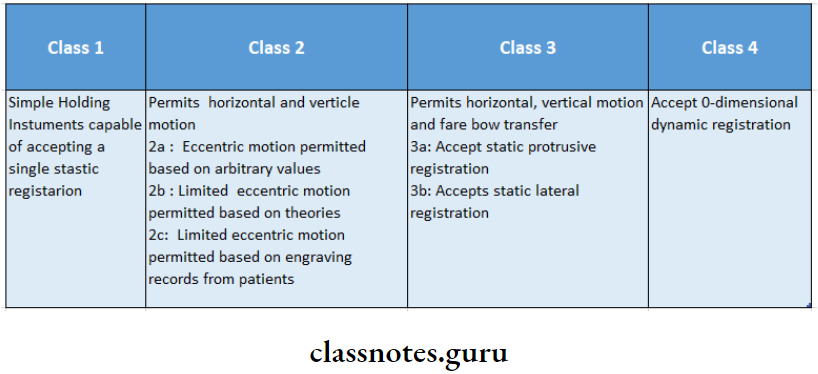
- Based On Adjustability
- Nonadjustable- can open and close in the fixed horizontal axis
- Semi-adjustable – have adjustable horizontal condylar paths, adjustable lateral condylar paths, and adjustable intercondylar distances
- Fully adjustable – capable of being adjusted to follow the mandibular movements in all directions
Laboratory Procedures Before Wax Try-In
2. Functions Of Articulators:
- Holds maxillary and mandibular casts in a determined fixed relationship
- Stimulates jaw movements like opening and closing
- Produces border and intraborder movements of the teeth similar to those in the mouth
3. Arcon And Non-Arcon Articulators:
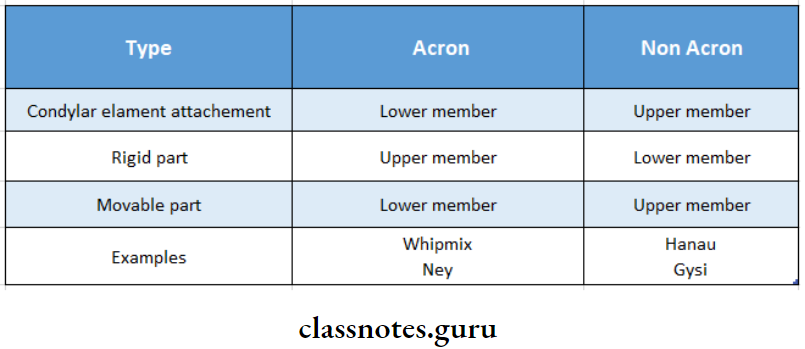
4. Dentogenic Concept – SPA Concept
- Sex:
- Females: rounded incisal edges
- Less angular teeth
- Incisal edges follow the plane of the curve of the lower lip
- Rotated distal surfaces of central
- A visible mesial third of canines
- Exposure of more anterior while smiling
- Males: More angular teeth
- Incisal edges are above the plane of occlusion
- The mesial end of laterals is hidden by central
- Middle 2/3rd of canine are visible
- Prominent cervical regions
- Females: rounded incisal edges
- Personality:
- Squarish – Vigorous people
- Flat: Executives
- Age:
- Increased horizontal overlapping of posteriors
- Reduced interarch distance
- Reproduce-abrasion, gingival recession in teeth as present in old individual
5. Types Of Teeth
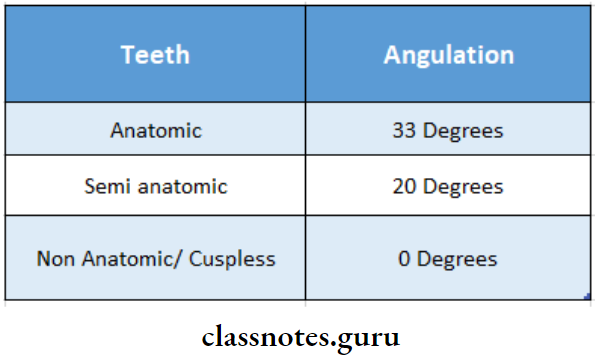
6. Indications Of Non-Anatomic Teeth:
- Flat ridges
- Knife edge ridges
- Large interridge space
- Milling type of chewing pattern
- In bruxers
- Patients with neuromuscular disorders In
- highly resorbed ridges
7. Separating Media:
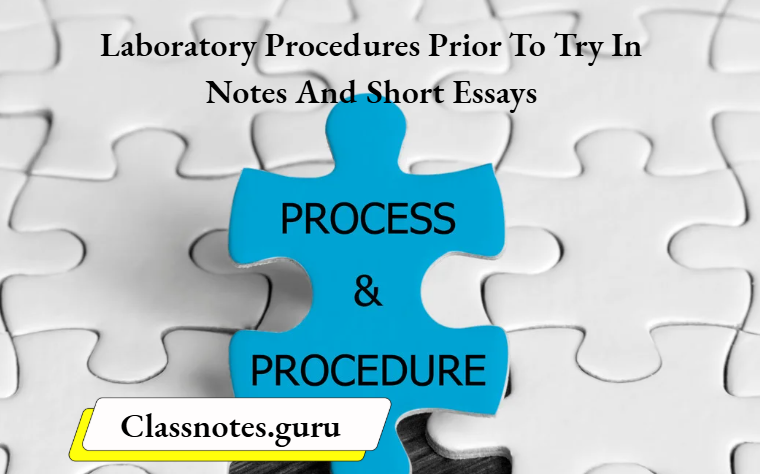
Separating Media Types:
- Tinfoil
- Cellulose lacquers
- Solution of alginate compound
- Calcium oleate
- Soft soaps
- Sodium silicate
- Starches
- Evaporated milk
8. Sodium Alginate Solution:
- Commonly known as cold mold seal
- Sodium Alginate is widely used because of its effective and easy manipulation
- Sodium Alginate Composition:
- Sodium alginate 2% in water
- Sodium phosphate
- Glycerine
- Alcohol
- Preservatives
- When applied overcast the sodium alginate in the solution reacts with calcium on the cast producing insoluble calcium alginate that forms a membrane and serves as separating medium
Laboratory Procedures Prior To Try In Short Essays
Question 1. The age factor in ketogenic concept
Answer:
Dentogenic Concept Integration Detail:
- Young people have lighter teeth due to translucent enamel
- Old people have dark & opaque teeth due to secondary dentin formation
- Shiny teeth in old people
- Teeth with a brownish tinge in older people
- Certain diseases are limited to certain ages Thus age can be used to rule out certain systemic conditions
- Age also determines the prognosis
Question 2. Nonanatomic teeth.
Answer:
Nonanatomic Teeth Definition:
Artificial teeth with occlusal surfaces are not anatomically formed but are designed to improve the function of teeth.
Advantages Of Non-Anatomic Teeth.:
- Useful in bruxers
- Greater range of movement possible
- Useful in patients with neuromuscular disorders
- Useful in patients with highly resorbed ridge
Disadvantages Of Non Anatomic Teeth:
- Unaesthetic appearance
- Less masticatory efficiency
- Balanced occlusion is not possible
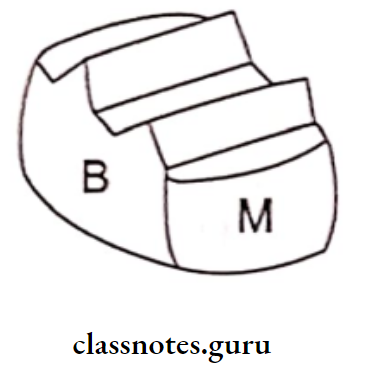
Question 3. Trial dentures.
Answer:
A trial denture is the arrangement of teeth in wax, for trial, prior to completion of the denture.
- On receipt of the articulated trial dentures, the first stage is to ensure that the maxillary and mandibular trial dentures are well adapted to the respective master casts and that both bases are stable.
- The next stage is to remove the mandibular trial denture from the articulator and to assess the relationship of the maxillary posterior teeth to the mandibular ridge.
- When both trial dentures have been removed from the articulator, the clinician should inspect the intermaxillary space to ensure no unplanned increase or decrease in dimension has occurred.
- The clinician should also examine the casts to ensure that no laboratory-induced defects have been induced on the denture-bearing areas.
- If both dentures are replaced on their respective casts, the clinician may then examine the occlusal relationships of both dentures, to establish the balanced occlusion
- Next dentures are inserted in the mouth and checked for extension, retention, and stability of dentures
- When both trial dentures are in the mouth, the following four aspects of the dentures may be assessed in turn:
- Occlusal relations: Vertical, anteroposterior, and coronal intermaxillary relations are checked for
- Occlusal planes: For evaluating the incisal plane, left and right posterior occlusal planes, and the plane of posterior mandibular teeth.
- Appearance of teeth and gingival: Tooth position, selection, and color of teeth are evaluated
- Speech: Should not be adversely affected by dentures.
Complete Denture Wax Try-In Preparation
Question 4. Try the procedure.
Answer:
Try In:
Try In is defined as a preliminary insertion of a removable denture wax-up a partial denture casting or a finished restoration to determine the fit, aesthetics, maxillomandibular relation
Try In Features: It includes following procedures
- Primary Evaluation:
- Check for adaptation of denture base
- Evaluation of complete occlusion of denture teeth in centric relation
- Verify vertical height at rest and occlusion
- Evaluate polished surface
- Preliminary Evaluation In Articulator:
- Evaluate impression surface for adaptation
- Evaluate polished surfaces for the absence of voids
- Evaluate the occlusal surface for any wax residues present
- Carve out gingival margins of the teeth
- Evaluation In The Mouth:
- Check for denture coverage and borders
- Evaluation Of Individual Trial Dentures:
- Evaluate denture extension, retention, stability, support, and esthetics
- Evaluate lip and cheek support:
- Evaluate Occlusal Plane, Vertical Height:
- Intraorally by the position of the parotid papilla and extraorally by interpupillary line and Camper’s line
- Evaluate centric and eccentric relation
Custom Tray Fabrication in Complete Dentures
Question 5. Semi-adjustable articulator.
Or
Arcon and non arcon articulator
Or
Define Arcon articulator
Answer:
Arcon articulators have adjustable horizontal condylar paths, adjustable lateral condylar paths, adjustable incisal guide tables and adjustable intercondylar distances
Semi-Adjustable Articulator Types:
- Arcon Articulator:
- In this type condylar element is attached to the lower member of the articulator & the condylar guidance is attached to the upper member
- This resembles the TMJ.
- Advantages: All relations are preserved even when the articular is open or closed
- Arcon Articulator Examples: Whip mix articulator:
- Non-Arcon Articulator:
- This articulator has a condylar element attached to the upper member
- The condylar guidance is attached to the lower member
- Non-Arcon Articulato is the reverse of TMJ
- Non-Arcon Articulato Examples: Hanau H series:
Question 6. Principles in teeth arrangement.
Answer:
1. Maxillary Central Incisor:
- The long axis of the tooth is parallel to the vertical axis
- Sloping labially
- Incisal edge contacts evenly
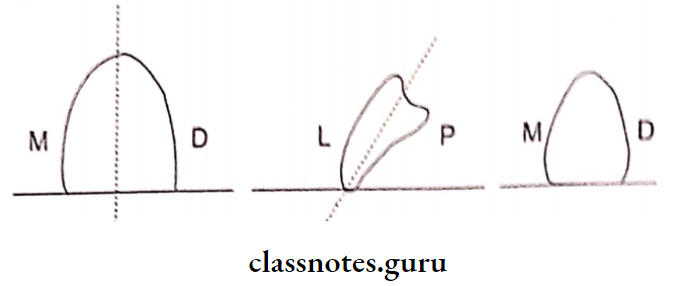
- M-Mesial
- D-Distal
- L-Labial
- P-Palatal
2. Maxillary Lateral Incisor:
- Long axis parallel to vertical axis, sloping labially
- Incisal edge 2 mm above the occlusal plane

- L-Labial
- P-Palatal
- M-Mesial
- D-Distal
3. Maxillary Canine:
- Long axis parallel to the vertical axis
- Mild mesial tilt
- Cervical prominence
- The cusp tip touches the plane of occlusion

- L-Labial
- P-Palatal
- M-Mesial
- D-Distal
4. Maxillary First Premolar:
- The long axis parallel to the vertical axis
- Buccal cusp touches occlusal plane
- Palatal cusp 0.5 mm above the occlusal plane
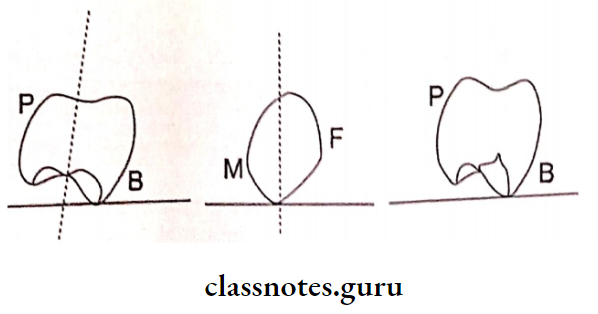
- P-Palatal
- B-Buccal
- M-Mesial
- D-Distal
Record Base and Wax Rims in Complete Dentures
5. Maxillary Second Premolar:
- Long axis parallel to the vertical axis
- Both cusps touch occlusal plane
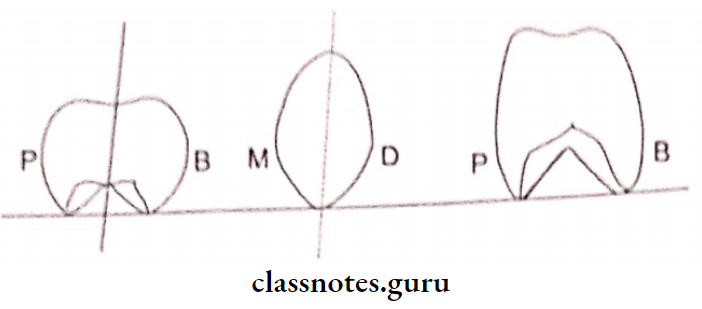
- P-Palatal
- B-Buccal
- M-Mesial
- D-Distal
6. Maxillary First Molar:
- The long axis tilted buccally
- Mesio palatal cusp touches the occlusal plane

- P-Palatal
- B-Buccal
- M-Mesial
- D-Distal
7. Maxillary Second Molar:
- Similar to the first molar but at a higher level
8. Mandibular Central And Lateral Molar:
- The long axis is parallel to the vertical axis and sloping labially
- Incisal edge 2 mm above occlusal plane
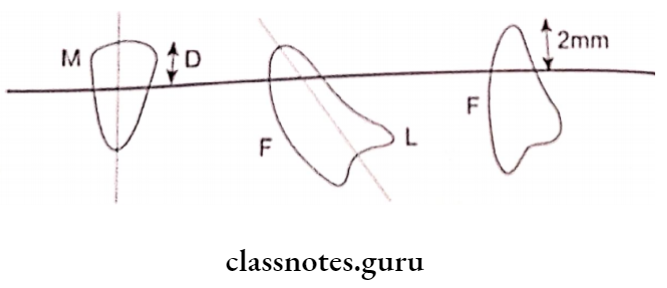
- M-Mesial
- D-Distal
- F-Facial
- L-Lingual
9. Mandibular Canine:
- Long axis parallel to the vertical axis and sloping lingually
- Cusp tip more than 2 mm of the occlusal plane
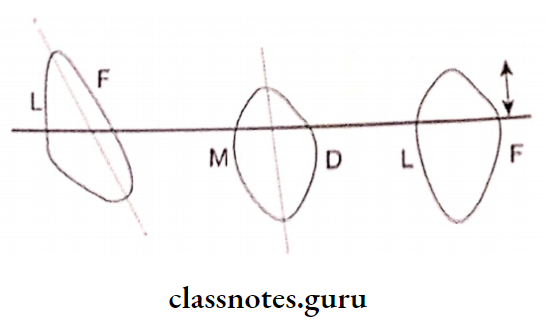
- M- Mesial
- D-Distal
- F-Facial
- L-Lingual
10. Mandibular First Premolar:
- Long axis parallel to vertical axis and sloping lingually
- Lingual cusp below the occlusal plane
- Buccal cusp 2 mm above occlusal plane
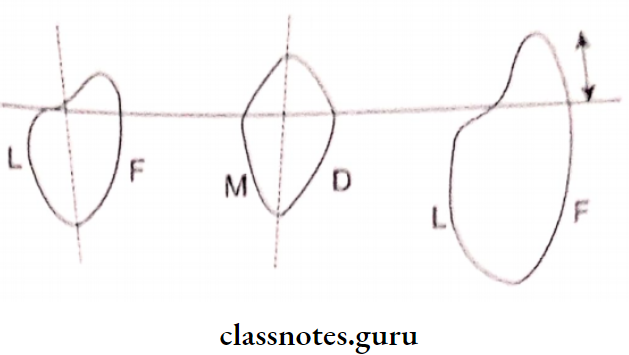
- P-Palatal
- B-Buccal
- M-Mesial
- D-Distal
11. Mandibular Second Premolar:
- Long axis parallel to vertical axis and sloping lingually
- Both cusps are 2 mm above the occlusal plane
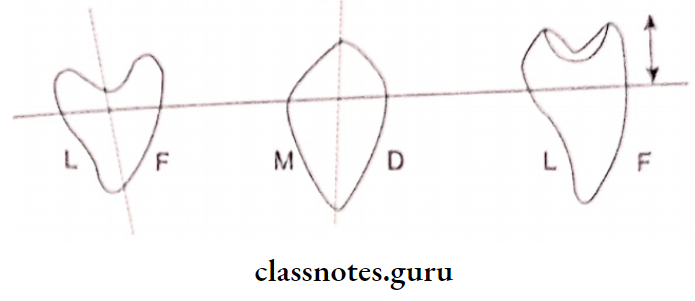
- M- Mesial
- D-Distal
- F-Facial
- L-Lingual
12. Mandibular First And Second Molar:
- The long axis parallel to the vertical axis and slopes lingually
- All cusps above the occlusal plane
- Mesial and lingual cusps at a lower level
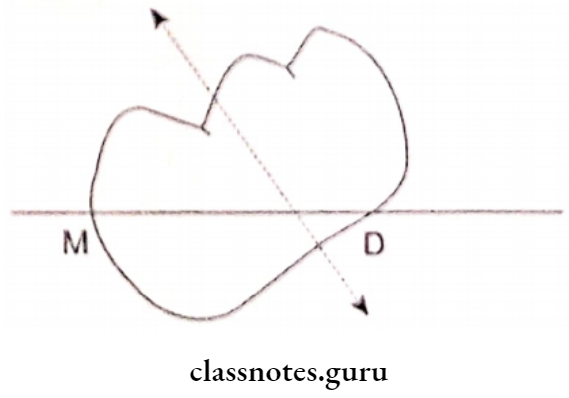
- L-Lingual
- F-Facial
- M-Mesial
- D – Distal
Pre-Try-In Lab Steps in Prosthodontics
Laboratory Procedures Prior To Try In Viva Voce
- While setting condylar guidance, the incisal guide pin should be raised out of contact with the incisal table.
- Alveolar sounds such as ‘s’, ‘n’, ‘d’, ‘t’, and ‘z’ are produced by contact of the tip of the tongue with the anterior part of the palate or the lingual side of the anterior teeth.
- If the teeth are too far anteriorly, the’d’ will sound like ‘t’. If the teeth are too far lingually, then that will sound like ‘d’.
- The labiodental sounds ‘f’ and ‘v’ are made between the incisal edges of upper incisors and the posterior 3rd of the lower lip.
- Labial sounds are b, p, and m
- The ketogenic concept is given by Frush and Fischer
- Artificial teeth must be arranged on a neutral zone
